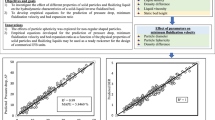Abstract
Bauxite pisolites found in the Cape York region of Australia are typically near-spherical particles . Ore extracted from the Andoom (Weipa) deposit is processed through a beneficiation plant to remove the finer fraction; these finer particles will otherwise lead to material handling problems. A key component of the beneficiation flowsheet is a fluidized bed classifier, where fine particles are removed via an overflow system. The objective of this project was to study and understand the solid/liquid separation phenomena taking place in the fluidized bed, especially determining the role of the granular properties in controlling the separation mechanisms. Laboratory-scale experiments, using a transparent tank and glass beads of controlled grain size in place of bauxite, allowed an accurate observation of the fluidized bed behavior. Computer modeling, using multi-phase flow, was used to perform numerical simulations of the experimental setup and establish the relative effects of the parameters that control the separation processes in the fluidized bed.
Access this chapter
Tax calculation will be finalised at checkout
Purchases are for personal use only
Similar content being viewed by others
Abbreviations
- c:
-
Compaction modulus
- g:
-
Gravitational acceleration, m2 s−2
- G0:
-
Reference elasticity modulus, Pa
- G(αs):
-
Elasticity modulus, Pa
- I:
-
Identity matrix
- p:
-
Pressure, Pa
- Ps:
-
Solid pressure, Pa
- Pp.kin:
-
Velocity fluctuation pressure, Pa
- Pp.coll:
-
Particle interaction pressure, Pa
- Pl:
-
Continuous phase pressure, Pa
- Vq:
-
Phase velocity, m s−1
- Vl:
-
Liquid phase velocity, m s−1
- Vs:
-
Solid phase velocity, m s−1
- αq:
-
Phase volume fraction
- αs:
-
Solid phase volume fraction
- αs,m:
-
Maximum solid volume fraction
- λs:
-
Solid bulk viscosity, Pa s
- µl:
-
Liquid viscosity, Pa s
- µs:
-
Particulate viscosity, Pa s
- ρq:
-
Phase density, kg m−3
- ρl:
-
Liquid Phase density, kg m−3
- ρs:
-
Solid Phase density, kg m−3
- ω:
-
Solid viscosity augmentation
- τl:
-
Liquid phase stress tensor
- τs:
-
Solid phase stress tensor
References
J. Ding and D. Gidaspow, “A bubbling fluidization model using kinetic theory of granular flow,” AIChE Journal, vol. 36, no. 4, pp. 523–538, 1990/04/01 1990.
D. Gidaspow, “Hydrodynamics of circulating fludized beds: kinetic theory approach,” 1992.
A. Aguilar-Corona, R. Zenit, and O. Masbernat, “Collisions in a liquid fluidized bed,” International Journal of Multiphase Flow, vol. 37, no. 7, pp. 695–705, 2011/09/01/ 2011.
E. Santiso and E. A. MÜLler, “Dense packing of binary and polydisperse hard spheres,” Molecular Physics, vol. 100, no. 15, pp. 2461–2469, 2002.
J. G. M. Kuerten and A. W. Vreman, “Collision frequency and radial distribution function in particle-laden turbulent channel flow,” International Journal of Multiphase Flow, vol. 87, pp. 66–79, 2016.
Y. M. Fridrun Podczeck, “The influence of particle size and shape on the angle of internal friction and the flow factor of unlubricated and lubricated powders”.
“ANSYS Fluent Theory Guide”.
E. P. a. A.-E. A. H. ENWALD, “EULERIAN TWO-PHASE FLOW THEORY APPLIED TO FLUIDIZATION,” 1995.
B. J. Konijn, O. B. J. Sanderink, and N. P. Kruyt, “Experimental study of the viscosity of suspensions: Effect of solid fraction, particle size and suspending liquid,” Powder Technology, vol. 266, pp. 61–69, 2014.
Acknowledgements
The authors would like to thank Mr. Eric Lemay and Mr. Pascal Vandal for their assistance in the laboratory. The authors are grateful to Matthew Lay (Principal Advisor Processing), Henry Provan and Emily Critchley (Process Engineer) for their support of this work. Thanks are also due to the Government of Canada and the Government of Québec for the granted MITACS scholarship. And, finally, thanks to Rio Tinto for financial support.
Author information
Authors and Affiliations
Corresponding author
Editor information
Editors and Affiliations
Rights and permissions
Copyright information
© 2020 The Minerals, Metals & Materials Society
About this paper
Cite this paper
Grillot, T., Simard, G., Chesnaux, R., Boudeville, D., Perrachon, L. (2020). Effects of the Granular Properties of Bauxite Pisolithes on the Solid/Liquid Separation in Liquid Fluidized Beds of Classifiers. In: Tomsett, A. (eds) Light Metals 2020. The Minerals, Metals & Materials Series. Springer, Cham. https://doi.org/10.1007/978-3-030-36408-3_2
Download citation
DOI: https://doi.org/10.1007/978-3-030-36408-3_2
Published:
Publisher Name: Springer, Cham
Print ISBN: 978-3-030-36407-6
Online ISBN: 978-3-030-36408-3
eBook Packages: Chemistry and Materials ScienceChemistry and Material Science (R0)




